Journeys in Steerage Archival Collection
This collection provides comprehensive documentation of the steerage experience on ocean liners from the 19th and early 20th centuries. It includes personal accounts, photographs, inspection cards, and illustrations, highlighting the harsh conditions faced by immigrants. The archives cover a wide range of topics, from the physical layout and hygiene conditions to the emotional and social aspects of steerage travel.
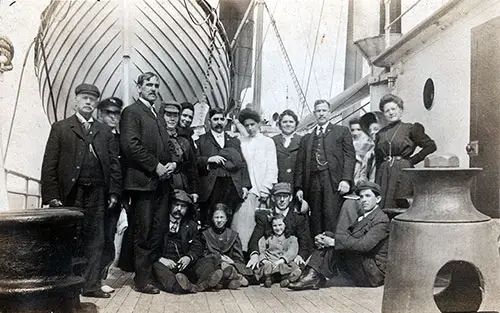
Steerage Passengers on the Deck of an Ocean Liner circa Early 1900s. Photograph from a Postcard. | GGA Image ID # 154782ffc3
On steamships, Steerage (or Tween Decks) and Third Class was the default choice of many immigrants from the 1850s through the 1930s. The conditions varied by steamship line and were likely to be relatively harsh compared to modern standards.
The steerage experience was grueling, with cramped and unsanitary conditions. Passengers often faced significant hardships during their voyages. Improvements in steerage conditions came gradually, influenced by regulations and public outcry.
Definition of Steerage
The expression "steerage passenger" means all passengers except cabin passengers, and persons shall not be deemed cabin passengers unless the space allotted to their exclusive use is in the proportion of at least thirty-six clear superficial feet to each passenger.
Pre World War 1 Steerage Conditions
Early steerage often housed hundreds of immigrants in one large room, often converted from cargo holds to hold what might have been described as human cattle. These potential new citizens were emigrants from many countries around the world who endured a journey unlike any other.
Westbound versus Eastbound Voyages in Steerage
The steerage from Liverpool to New York is one thing, the steerage from New York to Liverpool another. It is on the first-named voyage that one sees the wretched creatures huddling in groups like animals, shivering in abject terror at the motion of the water, croaking hoarsely in the obscure patois of remote European villages, and mumbling prayers at impromptu shrines.
Archival Collections Related to Steerage
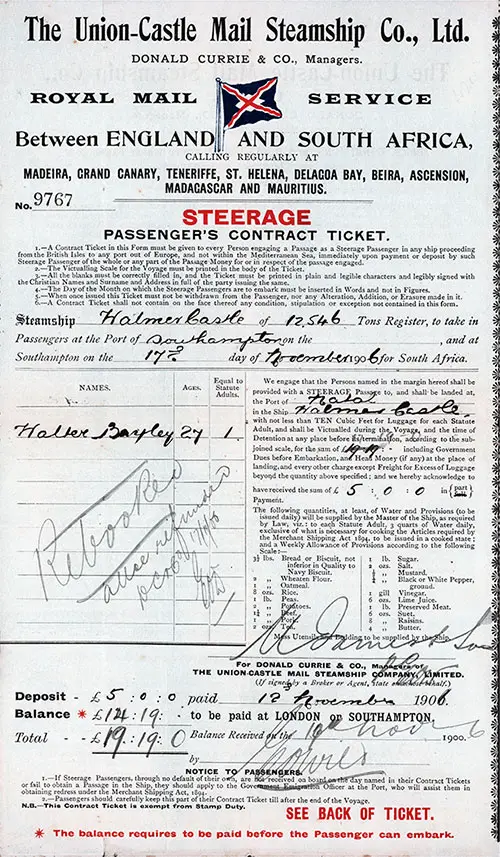
Front Page of Union-Castle Line Steerage Contract Between the UK and South Africa on the SS Halmercastle, Departing 17 November 1906 from Southampton. | GGA Image ID # 1d5689b846
Passage Contracts / Tickets / Receipts
The GG Archives has an assortment of extremely rare steerage class contracts, steamship tickets, and agent receipts that can assist you in identifying the type of document you have. These can also be used to illustrate your family history book as an example of what your ancestor's passage contract may have looked like.
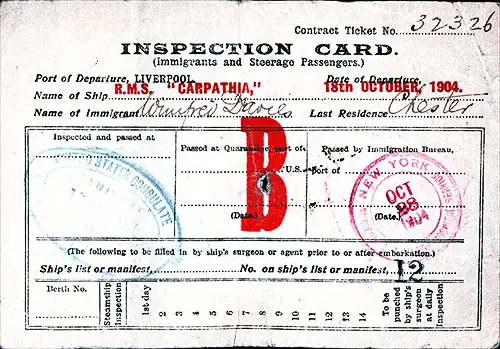
Immigrant Inspection Card for an Immigrant's Voyage on the RMS Carpathia of the Cunard Line, Departing from Liverpool on 18 October 1904. The Carpathia Would Become Famous in 1912, Coming to the Rescue of the RMS Titanic. | GGA Image ID # 1d56ae9e7e
Inspection Cards For Immigrants and Steerage Passengers
This collection presents inspection cards for steerage passengers, used between the late 19th and early 20th centuries. These cards documented essential details about immigrants, including personal information, health status, and journey specifics. They were crucial for identification and regulatory compliance throughout the travel and immigration process.
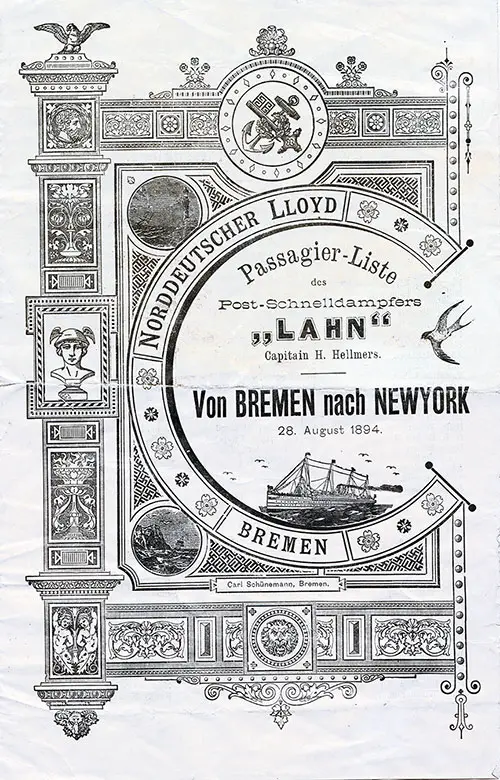
Front Cover of an Exceedingly Rare Steerage Passenger List From the 28 August 1894 Voyage of the SS Lahn of the Norddeutscher Lloyd (North German Lloyd). | GGA Image ID # 1d56af2b44
The Steerage Passenger Lists collection features rare documents detailing steerage passengers from various voyages. These lists, usually not preserved due to the lack of demand for souvenirs, provide valuable information about the immigrants who traveled under challenging conditions.
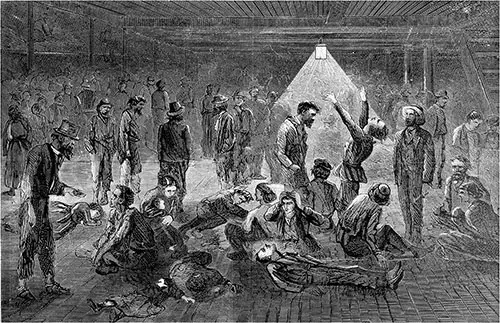
Horrors of the Emigrant Ship -- Scene in the Hold of the "James Foster, Jr." - 1869. Harper's Weekly, 27 March 1869. | GGA Image ID # 145fe7f646
Steerage (Immigrant Journeys) Illustrations Library
The Steerage Illustrations Library showcases a collection of images depicting the conditions and experiences of immigrants traveling in steerage from 1849 to 1898. These illustrations provide a visual history of the harsh realities faced by many immigrants during their journeys to new lands.
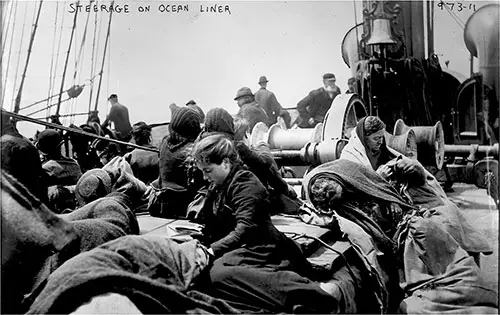
Steerage Passengers on the Deck of an Ocean Liner, 11 March 1897. Library of Congress # 2014684540. | GGA Image ID # 145f9f3609
Steerage (Immigrant Journeys) Image Library
The Steerage Image Library is a collection of photographs documenting the experiences of immigrants traveling in steerage from the late 1800s through World War I. The images provide a visual account of the conditions and lives of steerage passengers, offering a unique historical perspective.
Immigrants Enduring Hardships
- Their Journey in Steerage
- Steerage Conditions: An Intractable Problem
A Voyage in the Steerage of a Packet-Ship - 1832
This account details the experiences of steerage passengers on a packet-ship journey from Liverpool to New York in 1832. It vividly describes the harsh conditions, including overcrowded accommodations, poor hygiene, and inadequate provisions.
Journey In Steerage from Northern Europe - 1871
This article provides a detailed account of the conditions faced by immigrants traveling in steerage from Northern Europe to the United States in 1871. It describes the accommodations, food, separation of passengers, and the regulations imposed by various steamship lines.
Sanitary Conditions on Immigrant Ships - 1872
This report details the sanitary conditions on emigrant ships in 1872, covering the general arrangements, ventilation, hygiene, and dietary provisions. It provides an in-depth analysis of the facilities and the improvements needed to ensure better living conditions for passengers.
Cunard Line Steerage Accommodations - 1879
This article provides an account of the harsh conditions experienced by steerage passengers on a Cunard Line steamship in 1879. It describes the inadequate and often filthy accommodations, highlighting the neglect faced by lower-class travelers compared to their first-class counterparts.
Steerage Conditions Observed on the Cunard Line - 1881
This article discusses the observations of steerage conditions aboard the Cunard Line's "Bothnia" and "Gallia" in 1881. It details the living conditions, health concerns, and overall treatment of steerage passengers, contrasting them with the more comfortable accommodations for wealthier travelers.
The United States Passenger Act of 1882
The United States Passenger Act of 1882 established regulations for the transport of passengers by sea, particularly focusing on steerage conditions. It aimed to ensure adequate space, proper food, sanitary conditions, and safety measures for non-cabin passengers, addressing the overcrowded and unsanitary conditions that often plagued immigrant journeys.
Crossing the Atlantic in Steerage - 1884
This article recounts the experiences of steerage passengers on an 1884 transatlantic voyage, detailing the harsh living conditions, inadequate food, and lack of hygiene. It also highlights the diverse nationalities of the passengers and their interactions, including entertainments and daily routines during the voyage. The narrative emphasizes the challenges faced by immigrants seeking a better life in America.
The Sham Immigrant Journey in Steerage - 1888
This article narrates the experience of Eliza Putnam Heaton, who undertook a voyage in steerage from Liverpool to New York in 1888 to observe and document the conditions. The journey aimed to explore the realities faced by immigrants during their transatlantic passage.
Dinner in the Steerage of a Transatlantic Steamship - 1890
This article describes the meal arrangements for steerage passengers on a French Line steamship in 1890. It highlights the surprisingly good quality and quantity of food provided, which included breakfast, a midday meal, and dinner, with items like soup, meat dishes, vegetables, and fruit, complemented by wine. The narrative also notes the diverse nationalities among the passengers and the overall decent treatment and conditions, especially compared to other steamship lines of the time.
Immigrant Journey in Steerage - 1890
This account details the author's experiences traveling in steerage on a transatlantic voyage from England to the United States in 1890. It describes the discomfort and challenges faced by immigrants, including unsanitary conditions, limited space, and cultural interactions.
Stop Booking Steerage Passengers - White Star Line - 1892
This notice from the White Star Line informed agents to halt bookings for steerage passengers on certain voyages, as they were fully booked. It also provided details about availability and rates for upcoming sailings in different classes.
Life in the Steerage on the RMS Campania - 1895
The article describes the conditions and arrangements for steerage passengers on the RMS Campania in 1895. It highlights the sleeping accommodations, dining arrangements, and hygiene measures, emphasizing the efforts to maintain cleanliness and comfort for the passengers.
First-Hand Account of Steerage Conditions - 1898
This account details the experiences of immigrants traveling in steerage on a transatlantic steamship in 1897. It describes the poor conditions, the diverse passengers, and the difficult journey to the United States.
Immigrants and the Steamship Steerage Rate Wars - 1904
This article explores the intense competition among steamship companies in 1904, leading to drastic reductions in steerage rates. It discusses the resulting influx of immigrants, many of whom were deemed undesirable, and the impact on immigration laws and procedures.
Leslie's Magazine Takes A Stand on Immigration - 1904
This article from Leslie's Magazine critiques the U.S. immigration system in 1904. It highlights the perceived flaws in the system, particularly the entry of immigrants deemed undesirable. The magazine supports stricter immigration controls and proposes reforms to improve the vetting process.
The Fellowship of the Steerage - 1905
This article describes the experiences and conditions of steerage passengers aboard steamships in 1905. It highlights the harsh and often inhumane treatment of immigrants, overcrowded and unsanitary living conditions, and the communal bonds formed among passengers of diverse backgrounds during their journey. The narrative emphasizes the need for better treatment and living conditions for steerage passengers.
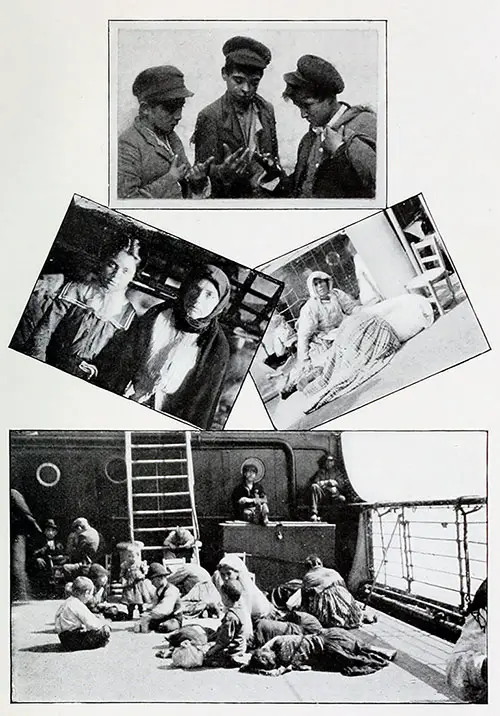
Steerage Realities: The Harrowing Journey of Immigrants at Sea (1906)
Kellogg Durland’s firsthand exposé of steerage conditions on transatlantic voyages offers a harrowing look at the realities faced by thousands of immigrants traveling to and from America in the early 20th century. The article details the staggering disparities between steerage and first-class accommodations, unsanitary conditions, inhumane treatment, and subpar food rations aboard major steamship lines like Cunard and White Star.
This powerful investigative report is particularly valuable for historians, teachers, genealogists, and maritime enthusiasts, as it reveals the grueling experiences of those who would later form the backbone of American society. Durland’s unique position as a journalist embedded within the steerage class offers a rare, authentic perspective, challenging the romanticized view of immigration.
Improvements in Conditions in Steerage Class and Increased Head Tax - 1907
This article discusses the significant improvements in steerage conditions on transatlantic steamships by 1907. The changes included better accommodations, enhanced hygiene, and improved food quality, elevating the experience to resemble that of second-class travel from a decade prior.
New Steerage Regulations - 1907
This article outlines the new regulations introduced in 1907, increasing the minimum space per steerage passenger on ocean steamships. The changes aimed to improve conditions for immigrants by expanding the required space and enhancing overall safety and comfort standards.
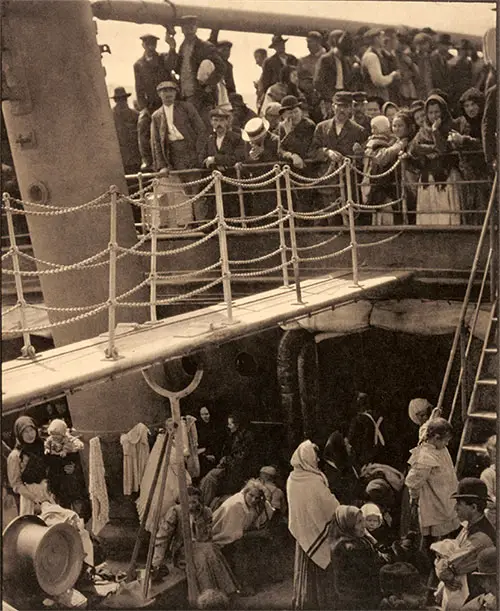
The Steerage, a Photograph by Alfred Stieglitz 1907. Camera Work, October 1911. | GGA Image ID # 147a072566
The Steerage: A Photograph by Alfred Stieglitz - 1907
This article analyzes Alfred Stieglitz's iconic 1907 photograph "The Steerage," taken aboard the Kaiser Wilhelm II. The image captures the everyday reality of steerage passengers, transcending traditional art concepts and emphasizing objective truth over conventional beauty.
Urgency of Improved Steerage Conditions - 1907
Kellogg Durland's article addresses the poor conditions faced by steerage passengers on transatlantic voyages. Through personal experiences and observations, it highlights the need for reforms to improve sanitation, accommodation, and overall treatment of passengers.
Section 42 of Passenger Act As Amended, 1908
The amended Section 42 of the U.S. Passenger Act of 1882, effective January 1, 1909, introduced stricter regulations for steerage conditions on passenger vessels. It outlined specific requirements for passenger space, accommodations, sanitation, and safety measures, aiming to improve the welfare of immigrants during transatlantic journeys.
Treatment of Women in Steerage - 1909
This report reveals the appalling conditions faced by women in steerage on transatlantic voyages, highlighting issues such as lack of privacy, poor hygiene, and mistreatment by male passengers and crew. The findings, presented to the U.S. Senate, call for urgent legislative reforms to protect female passengers.
Steerage Report Stirs Ocean Steamship Lines – 1909
This article discusses the reaction to a U.S. Immigration Commission report on the poor conditions in steerage on transatlantic steamships. The report sparked controversy, with several steamship companies and officials denying the accusations, particularly focusing on disparities in treatment between different routes and nationalities.
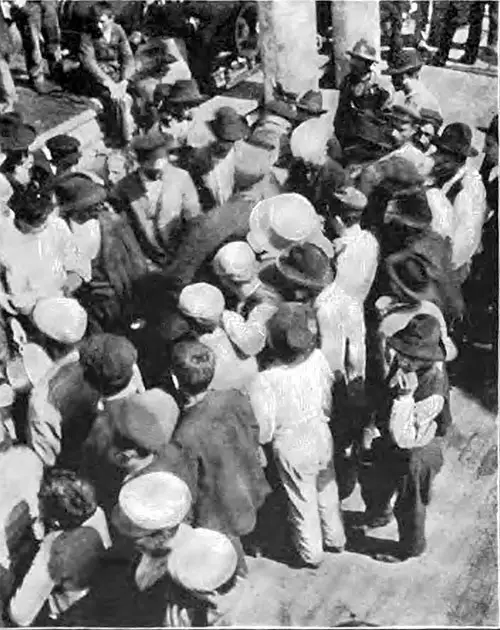
Steerage Suffering: The Hidden Abuses Faced by Immigrant Passengers (1910)
This shocking exposé unveils the harsh realities faced by immigrant passengers traveling in steerage on transatlantic steamships during the early 20th century. It highlights the unsanitary conditions, abuse, and mistreatment of immigrants, particularly women and children, during their voyage to the United States through ports like New York, Philadelphia, and Baltimore.
This article is historically significant as it presents firsthand evidence from secret investigations conducted by immigration officers and undercover agents working for the Department of Commerce and Labor. Their findings played a crucial role in pushing for reforms in immigration policies and shipboard regulations.
Steerage Conditions - Immigration Commission Report - 1911
This report, based on an investigation by the U.S. Immigration Commission, details the sanitary and living conditions in steerage on various transatlantic and coastwise ships in 1908. It highlights the significant disparities between old and new types of steerage, emphasizing the need for better regulations and oversight.
Steerage Conditions and Related Regulations - 1911
This report, presented by the U.S. Immigration Commission, investigates the living conditions in steerage on various transatlantic steamships. The comprehensive study highlights significant issues such as overcrowding, poor sanitation, and inadequate facilities, contrasting old-type and new-type steerage conditions.
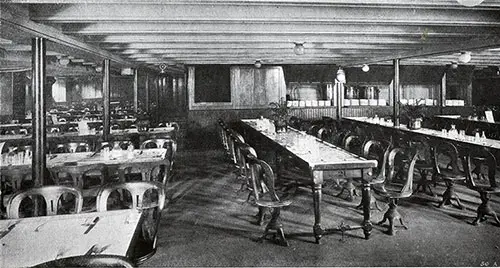
From Squalor to Progress: The Evolution of Steerage Class on Steamships (1912)
The early 20th century was a transformative period for ocean travel, particularly for immigrants journeying to the United States. This article provides a comprehensive examination of the improvements made to steerage accommodations, comparing the deplorable conditions of earlier voyages with the evolving standards on steamships by 1912.
For historians, genealogists, educators, and maritime enthusiasts, this article serves as an invaluable resource—shedding light on the harsh realities of steerage class, the driving forces behind reforms, and the gradual shift toward humane treatment of immigrants.
Worse Case of Steerage Passenger Abuse - 1912
The article reports severe neglect of steerage passengers aboard the British steamer Orteric in 1912. It describes the overcrowded, unsanitary conditions that led to 58 deaths, mainly children, and highlights the inadequate ventilation and medical facilities.
Conditions in Steerage - Then and Now - 1913
This article contrasts the appalling conditions of steerage passengers on steamships in the early 1900s with the improved conditions following regulatory changes. It highlights issues such as overcrowding, unsanitary environments, poor food quality, and lack of privacy, showing significant differences between old and new steerage accommodations.
The Cotterill Report on Steerage Conditions - 1913
The Cotterill Report, led by Ernest C. Cotterill, examines the poor conditions experienced by steerage passengers on transatlantic voyages. It highlights the need for reforms, including better sanitary conditions and moral oversight, to protect passengers, particularly women and children, from exploitation and unsafe conditions.
A Steerage Experience for Five Dollars - 1922
This article recounts the experience of traveling in steerage aboard a steamship for a mere five dollars, a cost that reflected intense competition among steamship lines. The narrative highlights the differences in service quality between American and Mediterranean routes, the latter often offering poorer conditions due to mismanagement by ship captains.
Recap and Summary of the Journeys in Steerage Archival Collection
The Journeys in Steerage Archival Collection at the GG Archives is an extraordinary resource documenting the experiences of immigrants and lower-class travelers who endured transatlantic voyages in steerage from the 19th to early 20th centuries. This collection captures the harsh realities of steerage travel, including firsthand accounts, rare photographs, inspection cards, passenger lists, and official regulations.
Steerage was the cheapest and most basic form of passage on ocean liners, primarily used by immigrants seeking new lives in America, Canada, and other destinations. The collection highlights horrific living conditions, such as overcrowding, poor sanitation, inadequate food, and a lack of privacy, while also showcasing the gradual improvements that resulted from public outcry, investigative journalism, and legal reforms.
This rich historical archive is invaluable to historians, genealogists, educators, and maritime enthusiasts, offering a powerful look into the experiences of millions of immigrants who shaped the modern world.
Highlighted and Most Interesting Content
1. First-Hand Accounts of the Steerage Experience
📌 Key Themes: Immigration, Hardships, Cultural Diversity, Social Bonds
One of the most compelling sections of this collection features first-person narratives from passengers who lived through the steerage experience. These accounts provide rare, personal insights into the emotional and physical toll of transatlantic travel.
💡 Why It’s Fascinating:
- "A Voyage in the Steerage of a Packet-Ship (1832)" vividly describes overcrowding, unsanitary conditions, and inadequate provisions for steerage passengers.
- "Crossing the Atlantic in Steerage (1884)" highlights the cultural mix of immigrants, their daily struggles, and their hope for a better life in America.
- "The Sham Immigrant Journey in Steerage (1888)" follows Eliza Putnam Heaton, a journalist who disguised herself as an immigrant to document the realities of steerage travel.
These personal stories bring history to life, making the reader feel the discomfort, fear, and resilience of those who endured these voyages.
2. The "Horrors of Steerage" Illustrated Collection
📌 Key Themes: Visual Depictions of Hardships, Public Awareness, Reform Movements
The Steerage Illustrations Library provides graphic depictions of steerage conditions, many of which were published in newspapers and magazines of the time.
💡 Why It’s Fascinating:
- The 1869 illustration "Horrors of the Emigrant Ship – Scene in the Hold of the James Foster, Jr." shows hundreds of immigrants crammed into dark, unsanitary conditions.
- Photographs of steerage passengers on deck (1897, 1900s, 1910s) offer real-life glimpses into the crowded and often miserable conditions on these voyages.
- Alfred Stieglitz’s 1907 photograph, "The Steerage", is an iconic image that captures the stark contrast between wealthy and poor passengers aboard the Kaiser Wilhelm II.
These visual documents were instrumental in exposing the horrors of steerage travel, sparking public outrage and calls for reform.
3. Government Reports and Legal Reforms on Steerage Conditions
📌 Key Themes: Policy Changes, Public Health, Passenger Rights
As public awareness of steerage conditions grew, governments were forced to act. This collection includes detailed reports and legislative reforms that sought to improve conditions for immigrants traveling in steerage.
💡 Why It’s Fascinating:
- The United States Passenger Act of 1882 set the first major regulations for steerage passenger accommodations, focusing on minimum space, food quality, and hygiene requirements.
- The 1907 U.S. Immigration Commission Report revealed continued abuses, overcrowding, and lack of sanitation, leading to stricter regulations.
- The Cotterill Report (1913) exposed poor treatment of women and children in steerage, highlighting the need for moral oversight and passenger protections.
These reports reflect the slow but significant improvements in steerage conditions, driven by investigative journalism, government intervention, and public demand for change.
4. Steerage Passenger Lists and Immigration Documents
📌 Key Themes: Genealogy, Historical Documentation, Immigration Process
The Steerage Passenger Lists and Immigration Documents section contains rare records that can be invaluable to genealogists tracing family histories.
💡 Why It’s Fascinating:
- Steerage Passenger Lists from the 1890s and early 1900s are exceedingly rare, as they were not preserved like first-class passenger lists.
- Immigrant Inspection Cards (1904, 1906) document the health status, nationality, and final destination of steerage passengers.
- Steerage Contracts and Tickets offer insights into how immigrants booked their voyages, including fares and travel conditions.
For family historians and researchers, these documents offer a direct connection to ancestors who made the treacherous journey across the Atlantic.
5. Steamship Line Responses and Industry Reactions
📌 Key Themes: Corporate Responsibility, Competition, Industry Evolution
This section explores how major steamship companies responded to criticisms of steerage conditions, often driven by public scrutiny and competition for passengers.
💡 Why It’s Fascinating:
- The 1904 "Steerage Rate Wars" article reveals how steamship companies slashed fares, leading to an influx of immigrants and concerns over unregulated mass migration.
- "Stop Booking Steerage Passengers – White Star Line (1892)" shows how overcrowding forced lines to halt steerage bookings, highlighting the immense demand for transatlantic travel.
- "Improvements in Conditions in Steerage Class (1907)" discusses how newer ships were outfitted with better ventilation, food services, and sanitation, making steerage travel more humane.
These articles show the tension between profit-driven shipping companies and the growing demands for humane treatment of passengers.
Why This Collection Matters
The Journeys in Steerage Archival Collection is one of the most comprehensive historical resources on immigrant travel by sea, offering a deeply human perspective on one of history’s greatest migrations.
Key Takeaways:
✅ First-Person Narratives Bring History to Life – The diaries and reports of steerage passengers provide emotional depth to historical events.
✅ Rare Visual and Documentary Evidence – Photographs, illustrations, and official documents allow modern audiences to see and understand steerage conditions.
✅ Insights into Immigration and Public Policy – The collection highlights how government regulations evolved in response to public outcry over inhumane conditions.
✅ Essential for Genealogy Research – For those tracing immigrant ancestors, these documents offer rare glimpses into their journeys and struggles.
✅ Maritime History and Steamship Evolution – The collection illustrates how competition and reforms changed ocean travel for millions of immigrants.
Final Thoughts
The steerage experience was one of hardship, resilience, and hope, and this collection honors the journeys of millions of immigrants who left their homelands in search of a better future. From harrowing personal stories to government reports that shaped immigration policy, the Journeys in Steerage Archival Collection is a historical treasure trove that preserves the voices of the past for future generations.
For anyone interested in immigration history, maritime travel, or genealogy, this collection is an invaluable resource that sheds light on an often-overlooked chapter of human migration.
⚠️ About Accuracy in Historical Records Research Tip
Context. The GG Archives presents passenger lists as faithfully as possible to the original documents. While OCR is generally accurate, portions of these collections—especially image captions and some transcriptions—are typed by hand and may include typographical or spelling variations. The original manifests themselves also contained clerical inconsistencies (names recorded phonetically, mid-voyage corrections, etc.).
What this means for your research:
- Search variant spellings of names (e.g., “Schmidt/Schmitt/Smith,” “Giuseppe/Joseph”).
- Cross-reference with immigration cards, passport applications, naturalization files, city directories, and newspapers.
- Treat manifests as primary sources with historical quirks—use them alongside corroborating records.
- For place names, consider historical borders and language variants (e.g., Danzig/Gdańsk, Trieste/Trst).
How to cite. When quoting a name from a manifest, consider adding [sic] for obvious misspellings and include a note such as “spelling as printed in original passenger list.”
Need help? If you spot a likely transcription error in captions, feel free to contact us with the page URL and a brief note—we love community input. 🙏
Curator’s Note
For over 25 years, I've been dedicated to a unique mission: tracking down, curating, preserving, scanning, and transcribing historical materials. These materials, carefully researched, organized, and enriched with context, live on here at the GG Archives. Each passenger list isn't just posted — it's a testament to our commitment to helping you see the people and stories behind the names.
It hasn't always been easy. In the early years, I wasn't sure the site would survive, and I often paid the hosting bills out of my own pocket. But I never built this site for the money — I built it because I love history and believe it's worth preserving. It's a labor of love that I've dedicated myself to, and I'm committed to keeping it going.
If you've found something here that helped your research, sparked a family story, or just made you smile, I'd love to hear about it. Your experiences and stories are the real reward for me. And if you'd like to help keep this labor of love going, there's a "Contribute to the Website" link tucked away on our About page.
📜 History is worth keeping. Thanks for visiting and keeping it alive with me.
